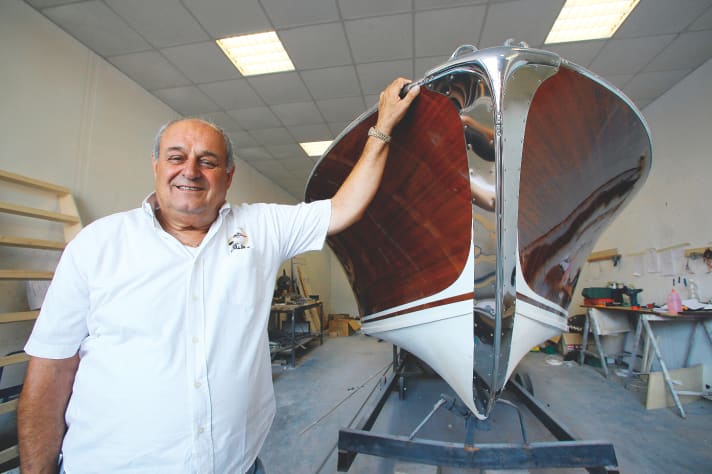







On the beautiful west coast of Lake Como, which is lined with prestigious, historic villas, people are used to seeing racing boats whizzing across the water like booming arrows. The phenomenon first appeared in the late 1940s, when Guido Abbate began building fast boats for the best drivers of the time. His eldest son Tullio never missed an opportunity to slip into the shipyard as a young boy as often as possible to watch his father's work in awe and breathe in the smells of wood, glue and petrol.
"I was happy that I was able to watch my father build Mario Verga's racing boat, which was equipped with Fangio's Alfa Romeo engine and set a new world record of 226 km/h in February 1953." (The Italian Mario Verga died a year later while boat racing on Lake Iseo. Juan Manuel Fangio (1911-1995) was an Argentinian motor racing driver and is regarded as one of the best in the history of Grand Prix motor racing. He drove an Alfa Romeo from 1950-51 and became world champion for the first time in 1951) Records were also set by Guido Abbate himself at the wheel of these powerful speedsters, and Tullio was sometimes even allowed to sit in the racing boat.
A marvellous vision
In 1960, at the age of sixteen, he won the European Championships in Cannes as a co-pilot. France played an early role in Tullio's life: "It was like a supernatural apparition. I took part in the six-hour race in Paris, and I saw a small V-hull, quite ugly and made of fibreglass." From that moment on, the young man knew what he had to do: "plastic" was the magic word, but it was completely impossible to convince his father, for whom the idea of using such material in boatbuilding was out of the question. For this reason, Tullio had to go his own way at the beginning. The rest, as can be read in the annals of racing boats, is history, one with a succession of victories (more than two hundred and fifty) and records, the last of which was set in 1997 in Campione, Italy, at a speed of more than 223 kilometres per hour.
The peculiar five
When Tullio Abbate is not at the helm, his famous lettering adorns the hulls of the winning boats in many categories, including powerful offshore racers. Within the successful logo, his name is associated with the number five. This was his first race number, assigned by Italian racing at the time, which he always kept as a lucky charm. It was this five that was emblazoned on his first self-designed (and built) racing boat in 1963, in which he won the "Regatta Centomiglia del Lario" at the age of just 19.
Success of the brave
When father Guido retired in 1975, Tullio, the eldest of the Abbate brothers, took over the business in Tremezzo and expanded the company. Since the mid-1980s, 250 boats have been delivered each year. Under favourable economic conditions, the company even built 350 at peak times. This spectacular development was due to Tullio Abbate's enormous sense of work and challenge. Starting with the first successful model, the Sea Star (see box), which was produced in its thousands, his shipyard gradually launched an ambitious collection of boats on the market, right up to 80-foot models.
This man, blessed with a strong instinct, is always able to recognise the right balance and develop hulls with the potential for high speeds and excellent seaworthiness. He also knows how to find the right partners when it comes to top quality. This is why his most innovative projects, the Superiority 60 and the Exception 70, bear the signature of the well-known industrial designer Giorgietto Giugiaro (Italdesign), who primarily designed automobiles, but also cameras and even locomotives.
As a tribute to his father, Tullio Abbate created the noble 32-foot Villa d'Este - a luxurious example of the famous Renaissance villa of the same name near Rome, which is a masterpiece of garden art. The boat is reminiscent of the golden age of mahogany runabouts, but is of course equipped with the latest technology.
In the company of famous people
In addition to design aspects, the idea of speed was always the main aspect of Tullio Abbate's work. He always felt comfortable in the company of Formula 1 drivers, who later became friends and customers; at the same time, his image as a designer of fast boats was consolidated throughout the world. Famous stars of the motor racing scene, such as Nikki Lauda (Austria), Keke Rosberg (Finland) and Riccardo Patrese (Italy), wrote in the Tremezzo guest book after racing across the lake alongside Abbate. The charismatic racing driver Ayrton Senna from Brazil, who died in an accident in 1994, even lent his name to a boat project: the 12.90 metre-long Senna 42 Evolution.
Abbate's boatyard on Lake Como has always invested in research into the marinisation of engines, often in collaboration with major car manufacturers such as Porsche, Lamborghini and Volkswagen. Many other well-known names, such as Sylvester Stallone and Madonna, are on the customer list. Perhaps a shipyard with such a rich history of success can cope better with the difficult times that all boat builders are currently going through. Today it is clear that the economic circumstances are very unfavourable, especially for the yacht industry in Italy.
Tullio Abbate's company also had to accept economic cutbacks and reduce its workforce. Nevertheless, the boss continues to dedicate himself consistently, passionately and with remarkable energy to improving the existing boat models and testing new designs with interest. At the historic shipyard site in Tremezzo, the family's fighting spirit seems unbroken.

